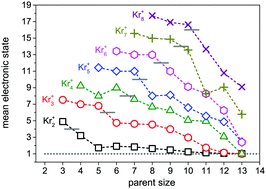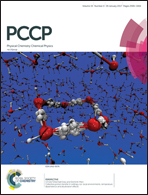Fragmentation of KrN+ clusters after electron impact ionization. Short-time dynamics simulations and approximate multi-scale treatment†
Abstract
Post-ionization fragmentation of small ionic krypton clusters, KrN+ (N = 3–13), has been investigated using a semiclassical non-adiabatic dynamics approach consisting of classical treatment of atomic nuclei and full quantum treatment of electrons, and an extended diatomics-in-molecules model including the spin–orbit coupling as well as leading three-body interaction corrections. Electronic quantum decoherence has also been considered via a simplified scheme proposed previously. The positive charge has been initially localized on a randomly selected atom in the form of a localized 2P1/2 positive hole. It follows from the calculations that the data are not converged at timescales usually considered in dynamical calculations (t = 200 ps in this work) and that an extension to t ≈ 1 μs is needed. An approximate multi-scale treatment developed recently has been used to provide such an extension of the output of dynamical calculations. A qualitative agreement with available experimental data has been achieved, in particular, the experimental observation that the monomer fragment, Kr+, completely dominates has been reproduced. Interestingly, stabilized neutral dimer and trimer fragments have been observed in our calculations at non-negligible abundances despite extremely weak bonding in these species.



 Please wait while we load your content...
Please wait while we load your content...